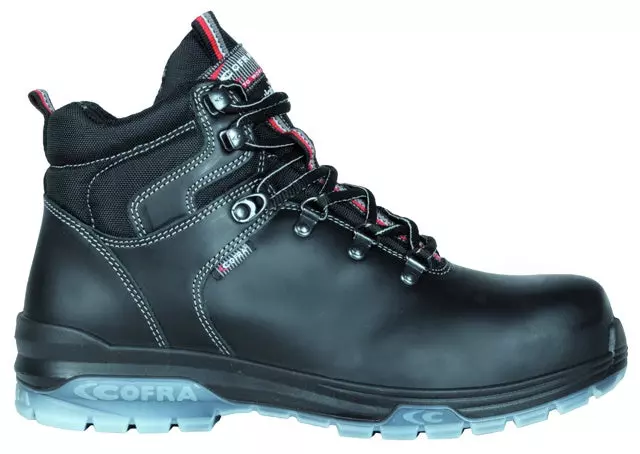Cofra Giuffre Work Shoes S3 WR CI SRC
Cofra
visit storeProduct description
Product Features:
- Water-repellent full-grain leather upper
- Breathable fabric outer lining
- SANY-DRY® inner lining:
— 100% Polyester
— Three-dimensional, breathable, antibacterial
— Moisture-absorbing and-releasing
— Abrasion-resistant
- Cold protection with Thinsulate™ B200
- EVANIT footbed:
— Made from EVA and nitrile mixture
— Variable thickness (12mm- 8mm- 3.8mm)
— Thermoformed and perforated
— High-quality, breathable coating
— Antistatic due to conductive threads
- Polyurethane/TPU sole
- TOP RETURN non-metallic toe cap (200 J protection)
- APT PLATE Zero Perforation non-metallic midsole
- Width: 11 Mondopoint
Additional Features:
- Sealed seams
- TPU toe cap
- Anti-torsion support
- Cold protection (CI)
- Waterproof
Standards:
- EN ISO 20345:2011
The material used to construct the shoe's bottom surface, affecting slip resistance, durability, chemical resistance, and comfort for different work environments.
Oil-resistant soles ensure secure footing and lasting durability in oily environments.
Anti-slip soles provide superior grip, keeping you safe and steady on challenging surfaces.
The external appearance of the shoe, affecting workplace compliance, professional look, and personal style preferences.
Determines the visual appearance of the shoe, affecting workplace compliance, professional look, and personal preference.
The interior material that lines the inside of the shoe, affecting comfort, moisture management, breathability, and temperature regulation during wear.
The method used to secure the shoe to your foot, affecting how easy it is to put on and take off.
Indicates the level of protective features, from basic safety compliance to enhanced protection with additional guards and reinforcements.
- Cold Protective
- Electrical Protection
- Water Resistance
- Slip Resistant
Request a free sample
Test first and buy later. Visit any product page to request your free sample.
Standards and labels
Test results
General Requirements CIThe CI designation in the standard EN ISO 20345:2011 refers to the insulation performance of footwear against cold. This specification indicates that the footwear offers insulation against cold conditions, protecting the wearer's feet from low-temperature environments. The test method for determining this involves measuring the temperature decrease inside the footwear when exposed to cold conditions over a specified period. This performance is crucial for footwear used in conditions where exposure to cold is significant, ensuring safety and comfort for the wearer in such environments. The practical implications for safety footwear in this category include enhanced worker safety and performance in cold climates, applicable to industries such as construction, cold storage, and outdoor operations in winter conditions.
General Requirements CRThe standard EN ISO 20345:2011 encompasses general requirements for safety footwear to ensure they provide adequate protection in various occupational environments. Rating 'CR' signifies that the footwear has a cut resistant upper ensuring enhanced protection. The test method involves assessing the material's resistance to splitting or cracking under certain conditions, which simulates real-world industrial hazards involving sharp objects or surfaces. Practically, this result ensures that the footwear is suitable for environments where there is a risk of materials splitting or getting caught, thereby providing essential safety benefits to the user.
General Requirements S3The EN ISO 20345:2011 standard specifies the general safety requirements for protective footwear used in various industries. The S3 designation under this standard means the footwear has met certain criteria, including basic toe protection, anti-static properties, energy absorption of the seat region, water resistance, fully enclosed heel, cleated outsole, and penetration resistance by a steel midsole. This classification involves specific test methods like compression and impact tests on toe protection, antistatic resistance tests, energy absorption verification at the heel section, water penetration, and absorption tests to ascertain the upper material's resistance, and penetration resistance tests to ensure the protective features of the outsole and midsole. For industries requiring protective footwear that can withstand mechanical risks, moisture, and sharp objects, achieving an S3 result guarantees a high safety level, making footwear that meets this requirement suitable for environments with increased moisture and at risk of foot penetration by sharp objects.
General Requirements WRThe standard EN ISO 20345:2011 includes various general requirements for safety footwear, among which the WR test result indicates that the footwear has been certified as water-resistant. This test result specifically means that the footwear has successfully passed evaluations confirming its capability to prevent water penetration under specified conditions. The test method involves the footwear being subject to a dynamic water test, where it is exposed to mechanical action in the presence of water for a certain period to simulate wearing conditions in wet environments. The practical implication of this result for safety footwear is significant as it ensures that the footwear provides adequate protection against water ingress, which is vital for individuals working in environments where exposure to water or dampness is frequent. This certification lends reassurance that the footwear will maintain its performance and comfort in challenging wet conditions, thereby improving wearer safety and job performance.
CE Marking is a label that shows a product meets certain safety and environmental standards set by the European Union. To get the CE Marking, a company must test and certify their product meets these standards. CE Marking is required for many products sold in the EU, including electronics, machinery, toys and medical devices. It helps ensure that products are safe for consumers and the environment, and allows for easy trade within the EU.
PPE stands for "personal protective equipment." PPE Category 2 refers to equipment that is more complex, and has a higher level of risk. Examples of PPE Category 2 include safety helmets, ear protection, and fall arrest equipment. In Europe, PPE Category 2 must meet certain safety standards set by the European Union, which means that it must be designed and manufactured to protect the user without causing harm. Companies that make or sell PPE must prove that it meets these standards. They also must have a quality management system in place and have to be audited regularly by a notified body.
Cofra delivery terms
Free delivery when you order more than 150,00 € from Cofra
Supplier shipping fee 6,68 €
Brand minimum 0,00 €
62,04 €
Shipping fee is 6,68 € for orders under 150,00 €
Sold in units of one pair
Need larger quantities?
Other products you may like
Recently viewed
Need help?
Get help from our experts
Other products you may like
Similar products you may like
Autonomous sourcing platform
The most efficient way to source and order supplies for your operations
Sourcing
Ordering
List products you’re looking for and we’ll find the best products and prices for you – all for free.
Need help?
Get help from our experts



